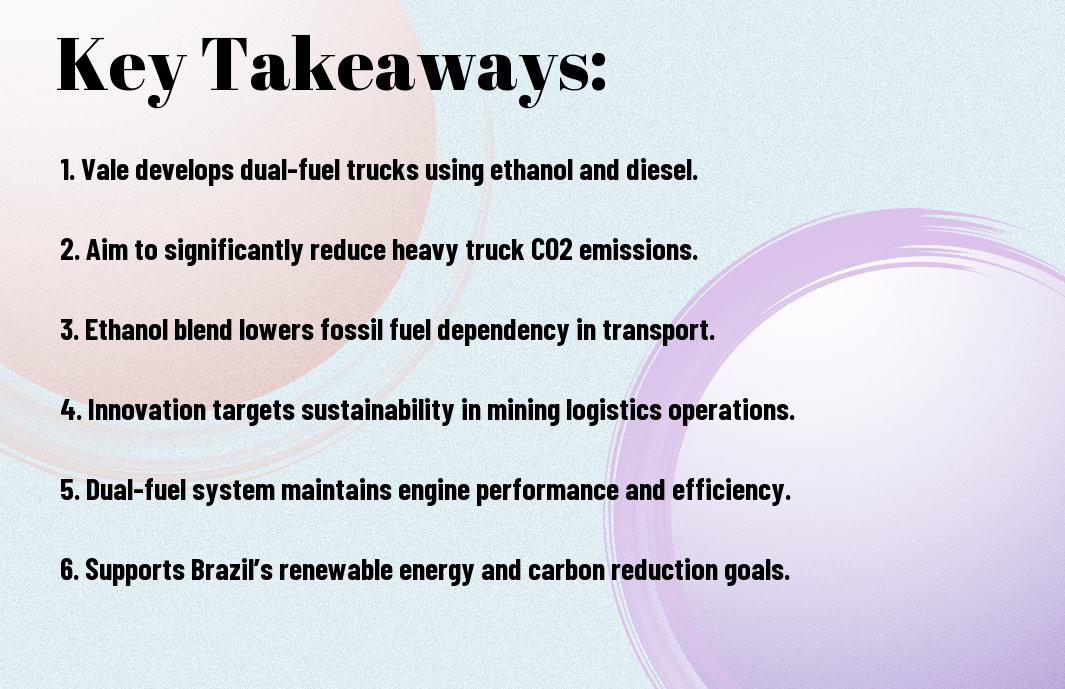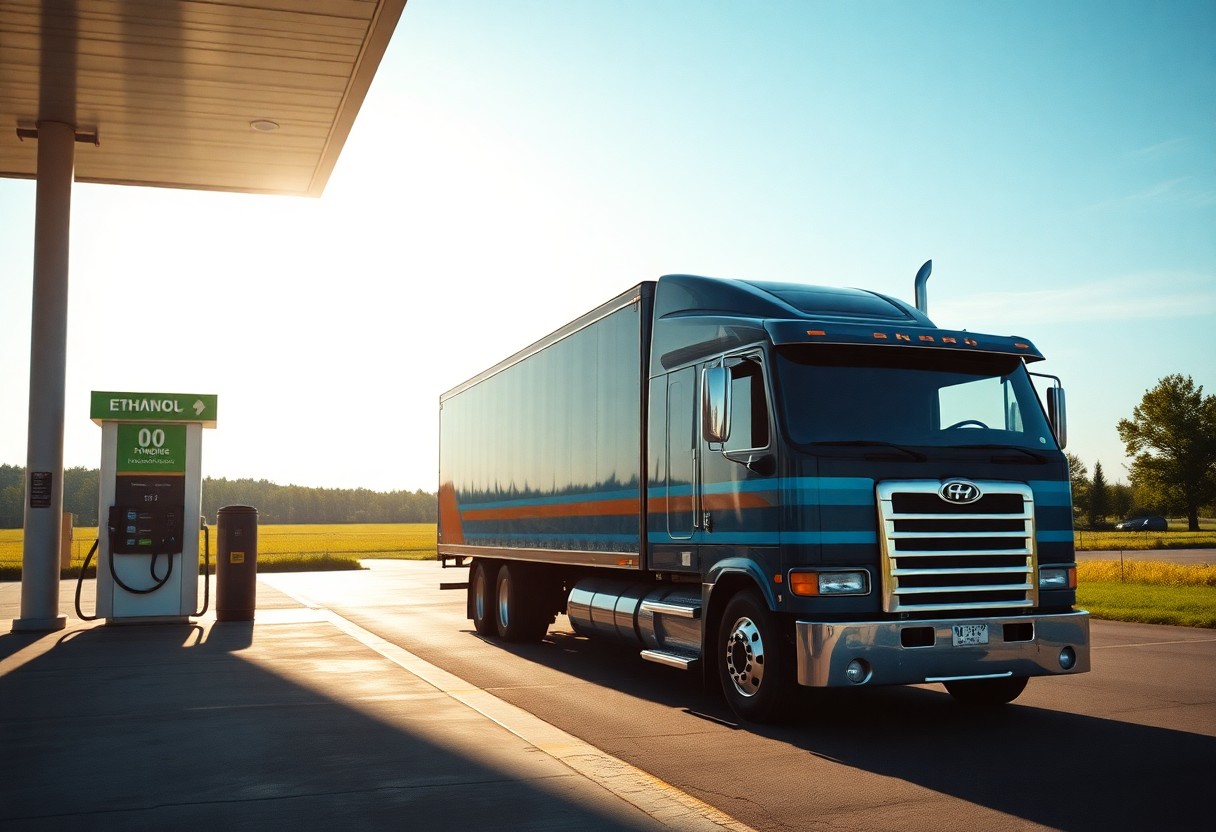Most people are increasingly aware of the need for sustainable practices in transportation. That’s why I’m excited to share with you how Vale is pioneering dual-fuel large trucks that run on both ethanol and diesel. This innovative approach not only aims to enhance fuel efficiency but also significantly reduces CO2 emissions, contributing to a cleaner environment. By adopting these advanced technologies, we can all play a part in a more sustainable future while benefiting from improved performance in heavy-duty transportation.
Key Takeaways:
- Vale is developing dual-fuel large trucks that can operate on both ethanol and diesel, aiming to integrate cleaner fuel options into their logistics operations.
- This initiative is part of Vale’s broader strategy to reduce CO2 emissions, demonstrating a commitment to sustainable practices in the mining industry.
- The adoption of dual-fuel technology could lead to significant advancements in fuel efficiency and lower greenhouse gas emissions compared to traditional diesel-only trucks.

Overview of Dual-Fuel Technology
As I investigate into the innovative realm of dual-fuel technology, it’s evident that this approach offers a promising solution for reducing emissions in large trucks. Dual-fuel systems allow engines to operate on two types of fuel simultaneously, typically an alternative fuel such as ethanol and a traditional fossil fuel like diesel. This technology takes advantage of the benefits of both fuel types, leading to improved fuel efficiency and lower CO2 emissions, which is crucial in tackling the pressing issue of climate change.
Definition and Mechanism
Among the various advancements in the automotive industry, dual-fuel technology stands out for its ability to optimize the combustion process. By combining ethanol with diesel, the system can significantly reduce the amount of diesel consumed, leading to a substantial decrease in greenhouse gas emissions. The mechanism involves injecting both fuels at strategic ratios, allowing for better combustion characteristics and maximizing energy efficiency.
Benefits of Dual-Fuel Systems
About the benefits associated with dual-fuel systems, they extend beyond just lowering emissions. These systems are designed to ensure that your vehicle remains efficient, adaptable, and responsive to varying fuel price fluctuations. By utilizing a mix of ethanol and diesel, you are reducing reliance on a single fuel source, which can help stabilize operational costs. Moreover, the inclusion of renewable ethanol can lead to a smaller carbon footprint, aligning with sustainability goals.
Hence, if you consider transitioning to a dual-fuel system, you’ll be making a significant step towards a more sustainable future. With the potential to cut down CO2 emissions significantly and reduce overall fuel exposure to the volatile fossil fuel market, this innovative approach is not just ideal for enhancing vehicle performance but also important for promoting environmental stewardship. Embracing dual-fuel technology in your fleet means you’re not only investing in economic efficiency but also in a cleaner, greener planet for future generations.
Vale’s Initiative
Assuming the growing concerns around climate change and the need for sustainable transport solutions, Vale has committed to innovating in the large truck sector by developing dual-fuel vehicles powered by both ethanol and diesel. This initiative aims to significantly reduce CO2 emissions, while also considering the economic implications for the transport industry. By diversifying fuel sources, I believe we can create a more resilient and environmentally-friendly logistics framework.
Project Goals and Objectives
Objectives for this initiative include reducing greenhouse gas emissions by 30% within the first five years of implementation. Additionally, it is vital to explore the feasibility of ethanol as a primary fuel source, enhancing the efficiency of fuel consumption in large trucks. I aim to foster collaboration with stakeholders across the industry, ensuring that best practices and technologies are shared and adopted widely.
Implementation Strategies
Strategies encompass the development of partnerships with renowned biofuel suppliers and technology companies that specialize in fuel-efficient systems. I will also prioritize research and development efforts, aiming to refine the dual-fuel engine technology for optimal performance. Moreover, pilot programs will be initiated to gather data and adjust our approach based on real-world applications.
Further, to ensure an effective rollout, it is necessary to establish comprehensive training programs for drivers and maintenance staff to familiarize them with the dual-fuel systems. I will also work on securing government support and incentives to promote the adoption of this technology. Through these efforts, I am confident that we can make significant strides towards a more sustainable transportation future while ensuring vehicle efficiency and operational reliability.
Ethanol as a Fuel Source
All around the world, the pursuit of sustainable energy sources has led to the increasing interest in ethanol as a viable fuel option, especially for dual-fuel large trucks. Ethanol, derived primarily from plant materials like corn and sugarcane, offers a renewable alternative to traditional fossil fuels. This biofuel can significantly lower the carbon footprint of heavy-duty vehicles, aligning with broader goals of reducing greenhouse gas emissions and promoting energy independence.
Advantages of Ethanol
At the forefront of the advantages of using ethanol as a fuel source is its ability to reduce carbon emissions. When burned, ethanol emits significantly less carbon dioxide compared to diesel, which contributes to cleaner air and better environmental health. Furthermore, the production of ethanol can lead to greater energy security since it can be produced domestically, lessening dependency on imported oil and enhancing local economies through agricultural growth.
Environmental Impact
The environmental impact of utilizing ethanol in dual-fuel systems is profound. The reduction in harmful emissions is one of the most significant benefits. Transitioning from diesel to an ethanol-diesel blend can lower NOT just CO2 emissions but also toxic pollutants that contribute to smog and health issues. Additionally, using ethanol produces less particulate matter, which is a key contributor to respiratory problems among urban populations.
In fact, the shift towards ethanol not only helps in combating climate change by reducing greenhouse gases but also supports the conservation of natural resources. Ethanol has a higher octane rating than gasoline, which allows for more efficient engine performance, subsequently leading to lower fuel consumption. Moreover, the agricultural processes that produce ethanol can be managed sustainably, ensuring that we minimize deforestation and biodiversity loss, making it a robust choice in the fight against climate change.
Diesel’s Role in Dual-Fuel Trucks
Now, as we examine into the mechanics of dual-fuel large trucks, it is important to understand the pivotal role that diesel plays in this innovative setup. Dual-fuel technology combines ethanol with diesel to leverage the strengths of both fuels. Diesel acts as an ignition source, ensuring that the engine operates efficiently while utilizing a larger percentage of ethanol. This synergy not only enhances fuel economy but also optimizes performance under various driving conditions, importantly allowing your truck to run smoother and handle heavier loads with reduced engine strain.
Performance Benefits
Against this backdrop, dual-fuel trucks offer several performance benefits. The primary advantage lies in the ability to use ethanol, which has a higher octane rating than diesel, translating to improved combustion efficiency. As a result, you may experience enhanced torque and horsepower, especially during acceleration. Moreover, because diesel serves as a pilot fuel for ignition, the engine can achieve better thermal efficiency, leading to prolonged engine life and reduced maintenance costs.
Emission Comparisons
Before we examine the environmental impact, it’s important to note how emissions stack up in dual-fuel scenarios versus traditional diesel trucks. The combustion of ethanol significantly reduces harmful particulates, nitrogen oxides (NOx), and carbon monoxide (CO) emissions. Let’s look at how these emissions compare:
| Emissions Type | Dual-Fuel (Ethanol & Diesel) |
| Carbon Dioxide (CO2) | Up to 30% reduction |
| Particulates | Up to 60% reduction |
| Nitrogen Oxides (NOx) | Up to 50% reduction |
Even with the compelling data on emissions, the transition to dual-fuel trucks is significant. One must consider regional infrastructure compatibility for ethanol as well as the initial costs associated with such technologies. However, the long-term benefits, such as decreased operating costs due to lower fuel prices and reduced environmental impact from less greenhouse gas emissions, make a compelling case for your business and the planet. In choosing dual-fuel trucks, you are not only investing in better performance but also contributing to a more sustainable future for the transport industry.
Challenges and Limitations
Many challenges arise in the development of dual-fuel large trucks powered by ethanol and diesel. One of the most pressing issues is the technical compatibility of existing diesel engines with ethanol. You need to ensure that the engine components can withstand the unique properties of ethanol, such as its lower energy density and potential corrosiveness. Moreover, tuning the engine for optimal performance while switching fuel sources presents a significant hurdle. Advanced engine management systems will be needed to balance the fuel ratios effectively, ensuring both efficiency and emissions reduction are achieved.
Technical Challenges
About the technical landscape, it is vital to recognize that the integration of ethanol not only affects engine design but also impacts the overall fuel delivery systems. You must consider factors like fuel storage, injector functionality, and combustion characteristics. The transition from diesel to a hybrid model could lead to a need for extensive testing to meet safety and regulatory standards, which can complicate and prolong the development timeline. Additional engineering efforts are required to address these variables before the technology can be widely adopted.
Market Acceptance
By considering market acceptance, I believe that public perception and industry readiness are significant barriers to the adoption of dual-fuel trucks. While the environmental benefits of lower CO2 emissions are clear, commercial fleets may be hesitant due to the perceived complexity of switching fuels and the current infrastructure limitations for sourcing and distributing ethanol. You might find that the economics of operating these vehicles will also play a substantial role in their acceptance, as the costs associated with retrofitting or purchasing new dual-fuel engines need to align with budgets and return on investment.
Also, addressing consumer education is important; many fleet operators may not be fully aware of the benefits and efficiencies achievable with ethanol-diesel combinations. As industry stakeholders, we need to facilitate discussions about the economic incentives and long-term sustainability advantages of using these dual-fuel systems. I believe that by working collaboratively to enhance understanding and develop supportive policies, we can pave the way for greater adoption and acceptance in the commercial sector.

Future Prospects
Your exploration into dual-fuel large trucks powered by ethanol and diesel brings exciting prospects for the future of transportation. As this technology gains traction, we can expect a significant shift towards reducing CO2 emissions in the trucking industry. With the ongoing advancements, there is potential for these vehicles not only to gain acceptance but also to inspire new regulations that prioritize sustainability. By investing in such innovations today, we can pave the way for a greener tomorrow, and thus improve air quality and public health for future generations.
Technological Advancements
Among the promising developments in the dual-fuel technology sector is the enhancement of engine efficiency and the integration of advanced fuel management systems. These innovations can lead to higher performance metrics while reducing dependency on purely fossil-based fuels. Moreover, the potential for bioethanol produced from renewable sources provides an environmentally friendly alternative, which may inspire further advancements in fuel production and supply chains. As new technologies emerge, the possibility of implementing automated systems to dynamically adjust fuel ratios will likely support optimal emissions reductions.
Policy and Regulation Implications
On a broader scale, the adoption of dual-fuel trucks powered by ethanol and diesel is intertwined with significant policy and regulation implications. As governments commit to reducing greenhouse gas emissions, they may implement incentives or mandates that support the transition towards cleaner alternatives in the transportation sector. This trend signifies the importance of aligning technological improvements with comprehensive policymaking that encourages the adoption of environmentally sustainable practices.
Indeed, emerging regulations are expected to ripple through the industry, creating opportunities for subsidies and tax breaks for companies transitioning to dual-fuel technology. Investors and manufacturers should stay informed of these legislative changes, as they could represent both a risk and an opportunity for growth in the sector. Furthermore, international agreements on climate change are likely to catalyze global collaboration in technology development and standardization, promoting a unified approach to enhancing efficiency and reducing carbon footprints in the transportation industry.
Final Words
Summing up, my exploration of Vale’s innovative approach to developing dual-fuel large trucks powered by both ethanol and diesel has provided valuable insights into the efforts being made to reduce CO2 emissions. By embracing these alternative fuel sources, I see how Vale, in collaboration with industry leaders like Komatsu and Cummins, is setting a benchmark for sustainable practices within the heavy equipment sector. This transition not only contributes to environmental sustainability but also offers potential economic benefits and operational efficiencies for businesses that prioritize eco-friendly solutions.
As you consider the implications of these advancements, I encourage you to explore deeper into the initiatives led by Vale. You can find more detailed information through this link: Vale, Komatsu, Cummins collaborate on dual-fuel engines. Understanding these developments helps us appreciate the potential impact of dual-fuel technology on reducing greenhouse gas emissions and fostering a more sustainable future in the transportation sector.
Q: What are the benefits of using dual-fuel large trucks powered by ethanol and diesel?
A: The dual-fuel large trucks utilizing both ethanol and diesel offer several benefits, including a significant reduction in CO2 emissions compared to traditional diesel-only trucks. Ethanol produces fewer greenhouse gases than diesel, thus helping to mitigate climate change. Additionally, using a mix of fuels can improve fuel efficiency and potentially lower operational costs for trucking companies. The shift towards renewable resources like ethanol also supports agricultural sectors by promoting the production of biofuels.
Q: How does the technology work in dual-fuel large trucks?
A: Dual-fuel technology allows the engine to operate using a combination of ethanol and diesel simultaneously. The truck’s engine is equipped with a control system that optimizes the use of both fuels for efficient combustion. Typically, the ethanol is injected directly into the combustion chamber along with a small amount of diesel, which is used to ignite the fuel mixture. This innovation reduces reliance on fossil fuels while maintaining the power and performance required for large trucks in the transport industry.
Q: What are the challenges faced in implementing dual-fuel trucks powered by ethanol?
A: There are several challenges in implementing dual-fuel trucks powered by ethanol. One major hurdle is the availability of ethanol fueling infrastructure, which is not as widespread as diesel. Trucking companies may also face initial costs associated with retrofitting existing engines or purchasing new dual-fuel trucks. Furthermore, there are considerations around fuel supply consistency and quality of ethanol, which can affect engine performance. Continued investment in technology and infrastructure, as well as collaboration with government and industry partners, will be crucial to overcoming these challenges.









